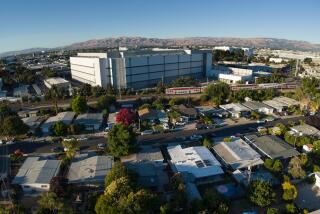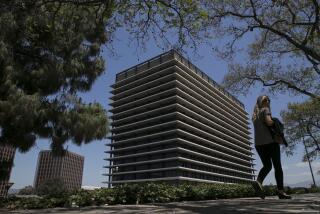Cathedral to Tap Solar Power for Electricity
- Share via
In a sign of religious commitment to the environment, Cardinal Roger M. Mahony and civic and religious leaders said Thursday that the soon-to-open Cathedral of Our Lady of the Angels will generate 10% to 15% of its electricity with a $600,000 solar panel that will go online in two weeks.
The array of solar photovoltaic cells, which converts sunlight into electricity, is one of the largest to be installed as part of the Los Angeles Department of Water and Power’s Green L.A. program. It also is the first of 16 solar panels to be installed this year at churches, synagogues, mosques and other religious buildings through the work of the Los Angeles Interfaith Environmental Council’s Green Sanctuaries program.
The downtown cathedral is to be dedicated Sept. 2.
Its solar panels, which cover 7,000 square feet on the roof of the cathedral’s nearby conference center, will generate 66 kilowatts of electricity, an amount equivalent to the power used by 66 single-family homes.
Renewable energy is prized because it reduces dependence on foreign oil, and is relatively “clean” compared to fossil fuels like natural gas, coal and oil, which produce pollutants that contribute to smog and to climate change.
Standing in the cathedral plaza and speaking through a microphone powered by solar energy, Mahony said there are religious as well as scientific reasons to safeguard the environment.
“In our tradition, our Christian tradition, we believe that human beings are stewards of all of God’s creation,” Mahony said. “How we care for God’s creation and environment are very important to us.”
He said the same sunlight that streams into the cathedral as a “beautiful sign and symbol of the transcendent” can also be used to produce clean energy.
An interfaith theme was underscored by Lee H. Wallach, co-chairman of the Los Angeles Interfaith Environmental Council. In the Midrash, rabbinical commentaries on the Scriptures, it says, “ ‘Do not corrupt or desolate my world, for if you do, there will be no one to repair it after you.’ It says in the Koran, ‘Eat, drink, but waste not by excess, for Allah loves not the wasters,’ ” Wallach said. He added that because environmental destruction often takes its toll on the planet’s poorest and most vulnerable citizens, the responsibility of faith communities to care for creation is magnified.
“Today we are not only sustaining the quality of life and the environment for our children and grandchildren,” Wallach said. “We are establishing the moral compass for the rest of the country by setting this extraordinary example of environmental stewardship.”
Civic and religious leaders said they hope that as congregants see what can be done in their own places of worship, they will want to undertake similar programs in their homes and businesses.
About half the cost of the $600,000 installation was paid for by the DWP under its “buyback” program to encourage the installation of clean, renewable energy. Buyback programs also are available for residential, commercial and industrial customers. For example, a typical single-family home installation would run about $20,000. The homeowner’s share after the buyback would be about $8,000, with the DWP paying $12,000. Depending on where the house is and the cost of electricity over the years, it would take five to 10 years for the typical residential system to pay for itself, said Angelina Galiteva, executive director of the Green L.A. program.
Solar panels are warranted for 25 years. But she said panels built 45 to 50 years ago are still working with little degradation. Solar electricity costs 18 cents to 22 cents a kilowatt-hour, compared to 10 cents for conventional electricity in the DWP service area, she said.
Under the buyback program, the DWP will either send a rebate check to homeowners and businesses who install solar energy, or send it to the installer, thereby reducing the price to the consumer. The DWP has a toll-free number for those considering green energy: (800) 473-3652.
More to Read
Sign up for Essential California
The most important California stories and recommendations in your inbox every morning.
You may occasionally receive promotional content from the Los Angeles Times.













